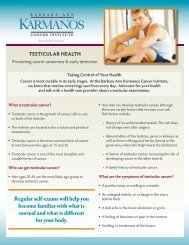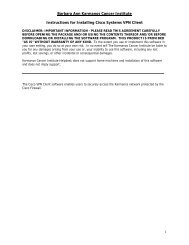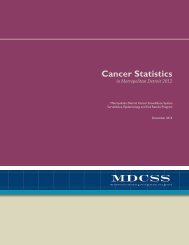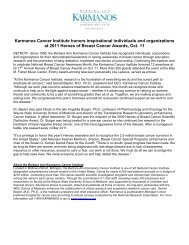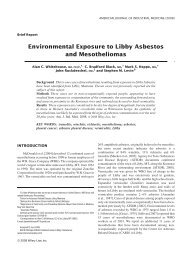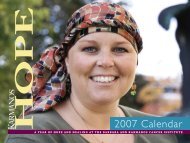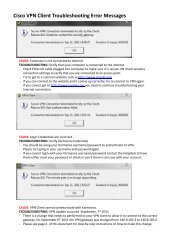Familial Adenomatous Polyposis - Karmanos Cancer Institute
Familial Adenomatous Polyposis - Karmanos Cancer Institute
Familial Adenomatous Polyposis - Karmanos Cancer Institute
Create successful ePaper yourself
Turn your PDF publications into a flip-book with our unique Google optimized e-Paper software.
The Johns Hopkins Guide for<br />
Patients and Families:<br />
<strong>Familial</strong><br />
<strong>Adenomatous</strong><br />
<strong>Polyposis</strong>
The Johns Hopkins Guide for<br />
Patients and Families:<br />
<strong>Familial</strong><br />
<strong>Adenomatous</strong><br />
<strong>Polyposis</strong><br />
© 2000 The Johns Hopkins University
THE JOHNS HOPKINS GUIDE<br />
FOR PATIENTS AND FAMILIES:<br />
FAMILIAL ADENOMATOUS POLYPOSIS<br />
TABLE OF CONTENTS<br />
Introduction ……………………………………………………………………………1<br />
What are Polyps ………………………………………………………………………2<br />
What is <strong>Familial</strong> <strong>Adenomatous</strong> <strong>Polyposis</strong> (FAP)? …………………………………2<br />
What is Attenuated FAP (AFAP)?……………………………………………………2<br />
What is the Gastrointestinal Tract? …………………………………………………3<br />
How is FAP Inherited? ………………………………………………………………4<br />
DNA Test for FAP ……………………………………………………………………4<br />
Why is Early Diagnosis Important? …………………………………………………6<br />
Exam Guidelines for People At Risk ………………………………………………6<br />
What are the Symptoms of FAP?.……………………………………………………7<br />
Other Tumors Associated with FAP…………………………………………………7<br />
How is FAP Diagnosed?………………………………………………………………8<br />
What is the Treatment? ………………………………………………………………9<br />
Sexual Function and Childbirth After Surgery ……………………………………9<br />
Guidelines for Follow Up Care for People with FAP ……………………………0<br />
Support Groups for Individuals and Families ……………………………………11<br />
Resources ……………………………………………………………………………12<br />
Publications …………………………………………………………………………14<br />
Glossary ………………………………………………………………………………15<br />
Appendix ……………………………………………………………………………18
INTRODUCTION<br />
This booklet is written for individuals with familial adenomatous polyposis (FAP)<br />
and their families. The information provided is intended to add to, and is not a substitute<br />
for, discussions with doctors, genetic counselors, nurses, and other members of the<br />
health care team. We encourage you to read the entire booklet in the order in which it is<br />
written since each section is built on information in preceding sections. We want to<br />
emphasize the need for regularly scheduled, thorough medical examinations for persons<br />
who already have FAP. More importantly, relatives at risk for this condition need<br />
to have regular examinations beginning at an early age. Names of support groups and<br />
additional publications concerning this condition are found at the end of the booklet.<br />
The information included in this booklet can also be found on the Johns Hopkins<br />
Hereditary Colorectal <strong>Cancer</strong> website, www.hopkins-coloncancer.org. Please visit that<br />
site to find the most current information on FAP.<br />
1
WHAT ARE POLYPS?<br />
Polyps are abnormal, mushroom-like growths. When found in the gastrointestinal<br />
tract, they occur most commonly inside the colon (large intestine, large bowel). Less<br />
often they develop in the stomach and small intestine (small bowel). Polyps vary in size<br />
from less than one-tenth of an inch to 1-2 inches. They may be so large as to block part<br />
of the intestine. In some people polyps may be inherited, while in others they are not<br />
inherited.<br />
WHAT IS FAMILIAL ADENOMATOUS POLYPOSIS (FAP)?<br />
FAP is a condition in which the tendency to develop large numbers of a certain<br />
type of polyp is inherited. These polyps are called adenomatous polyps or adenomas.<br />
This hereditary (genetic) disease mainly affects the gastrointestinal tract. Other names<br />
for this condition are hereditary polyposis of the colon, familial polyposis, and Gardner<br />
syndrome. Individuals with this condition typically develop hundreds to thousands of<br />
polyps throughout the colon at a young age, usually as a teenager or young adult. The<br />
major concern in this condition is that the adenomatous polyps will become cancerous.<br />
WHAT IS ATTENUATED FAP (AFAP)?<br />
Some families are affected with Attenuated FAP (AFAP). This is a mild (or attenuated)<br />
form of FAP in which affected individuals develop fewer polyps at a later age<br />
than those with typical FAP. Although people with AFAP tend to develop colon cancer<br />
at a later age than individuals with typical FAP, people with AFAP still have a near<br />
100% lifetime risk of colon cancer. If AFAP is suspected within a family, it is important<br />
that family members be screened with colonoscopy rather than flexible sigmoidoscopy<br />
since polyps are not evenly distributed through the colon in AFAP. Because the number<br />
of polyps and age of onset can vary greatly from one family member to another in<br />
a family with AFAP, screening should begin at age 11.<br />
2
WHAT IS THE GASTROINTESTINAL TRACT?<br />
The gastrointestinal digestive tract is a hollow tube which begins at the mouth<br />
and ends at the anus. It has several parts including the esophagus, stomach, small<br />
intestine and colon (large intestine). Its total length is about 28 feet. The last 5-6 feet of<br />
the intestine is called the colon (large intestine, large bowel). The last 5 or 6 inches of<br />
the colon is the rectum. After food is digested, solid wastes move through the colon and<br />
rectum to the anus, where they are passed out of the body.<br />
}<br />
3
HOW IS FAP INHERITED?<br />
FAP is an autosomal dominant condition. This means that people with FAP have<br />
a 50% chance of passing the condition to each of their children. The condition can be<br />
passed on even if the parent has had his or her own colon removed. Children who are<br />
not affected with the condition cannot pass it to their own children.<br />
About one-third of people with FAP do not have an affected parent. These individuals,<br />
who are the first in the family to have the condition, have a new mutation of<br />
the gene. They can pass FAP to their children.<br />
Genetic counseling is available, and recommended, for families affected with FAP.<br />
Genetic counselors are trained to explain hereditary conditions and the advantages and<br />
disadvantages of genetic testing. Counseling services are available through genetics<br />
and oncology departments in many hospitals. Also it is recommended that families<br />
with FAP contact local registries (see RESOURCES) for access to resources and for help<br />
with identification of family members at risk.<br />
DNA TEST FOR FAMILIAL ADENOMATOUS POLYPOSIS (FAP)<br />
FAP is caused by a mutation (change) in the <strong>Adenomatous</strong> <strong>Polyposis</strong> Coli (APC)<br />
gene. A blood test can locate the change in the APC gene which is causing the disease<br />
in about 80% of families with FAP. In these families, children can learn if they have<br />
inherited the changed APC gene from the parent with FAP. If a child does have the gene<br />
mutation, he or she will eventually develop FAP. The mutation in the APC gene cannot<br />
be detected in about 20% of families with FAP. Children in these families must continue<br />
to have regular colon screening according to the guidelines on page 6.<br />
The test requires a small blood sample. The gene test results will influence the future<br />
management of individuals who are at risk for FAP. For example, if the test shows that a<br />
person does not have the APC gene mutation known in the family, he or she can avoid<br />
many unnecessary colon examinations. If the test shows that a person does have the gene<br />
mutation, then the physician will need to be alerted to schedule colon examinations at<br />
least yearly and to plan for future treatment when polyps develop.<br />
4
(1)<br />
George Jones<br />
Susan<br />
(2) (3) (4)<br />
George, Jr. Connie Stephen Gloria Bill Smith Carol<br />
George III Alice James Susan<br />
Peter Sally<br />
OR<br />
OR<br />
= male or female affected with FAPC<br />
= male or female unaffected<br />
= husband and wife<br />
(1) George Jones has FAP. His wife, Susan, is unaffected. They have three<br />
children, George, Jr., Stephen and Carol. All were at 50% risk of developing<br />
FAP. George, Jr. and Carol are affected.<br />
(2) George, Jr. and his wife Connie have two children. Although both children<br />
had a 50% chance of inheriting FAP, neither did.<br />
(3) Stephen and his wife, Gloria, have two children. Since Stephen is unaffected,<br />
there was no risk of FAP to his children.<br />
(4) Carol and Bill Smith have two children. Both had a 50% chance of inheriting<br />
FAP and both are affected.<br />
5
WHY IS EARLY DIAGNOSIS IMPORTANT?<br />
Early diagnosis is important for early detection and prevention of cancer. Regular<br />
screening should start as a young teenager, because when FAP is detected early, treatment<br />
will nearly always be effective. Furthermore, early and frequent examination<br />
might reassure a person without polyps that he or she does not have the disorder even<br />
though relatives do.<br />
EXAM GUIDELINES FOR PEOPLE AT RISK<br />
Follow the guidelines listed below if:<br />
• You have never had gene testing for FAP or if a family member with FAP had DNA<br />
testing and a mutation could not be found.<br />
Age<br />
Birth - 7 yrs<br />
Examination<br />
Physical exam and/or abdominal ultrasound for liver enlargement and<br />
serum alpha-fetoprotein test every year to check for hepatoblastoma.<br />
11-24 yrs Flexible sigmoidoscopy* every year<br />
25-34 yrs Flexible sigmoidoscopy* every other year<br />
35-50 yrs Flexible sigmoidoscopy* every 3 years<br />
over 50 yrs<br />
Flexible sigmoidoscopy* every 3-5 years<br />
If polyps are found, surgery will be recommended<br />
• You have had DNA testing and you do have a gene mutation causing FAP.<br />
Age<br />
Birth - 7 yrs<br />
Starting at age 11<br />
Examination<br />
Physical exam and/or abdominal ultrasound for liver enlargement and<br />
serum alpha-fetoprotein test every year to check for hepatoblastoma.<br />
Flexible sigmoidoscopy* every year<br />
If polyps are found, surgery will be recommended<br />
• You have had DNA testing and you do not have the gene mutation causing FAP that<br />
was found in your affected family member<br />
Age<br />
Examination<br />
25-30 yrs To be certain that the DNA test was correct, a flexible<br />
sigmoidoscopy* should be performed at least once between the<br />
ages of 25 and 30.<br />
*Colonoscopy recommended in place of flexible sigmoidoscopy for families with Attenuated<br />
FAP (AFAP)<br />
6
WHAT ARE THE SYMPTOMS OF FAP?<br />
Most patients develop polyps without symptoms. However, the following<br />
symptoms may occur:<br />
1. Bright red blood in the stool<br />
2. Periods of diarrhea and/or constipation not explained by diet or flu<br />
3. Crampy pain in the stomach region<br />
4. Pencil thin stools<br />
5. Frequent feeling of distention (or bloating) in the abdominal or<br />
bowel region<br />
6. Weight loss - persistent and unexplained<br />
7. Unusual and continuing lack of energy<br />
In addition to polyps, abnormalities in other areas of the body may give early<br />
clues to the presence of FAP. These signs include: lumps or bumps on the bones of the<br />
legs, arms, skull, and jaw; cysts of the skin; teeth which do not erupt when they should;<br />
and freckle-like spots on the inside lining of the eye.<br />
It should be emphasized that there is no safety in simply waiting for symptoms to<br />
develop. It is vital that parents and guardians make every effort to have examinations of<br />
their children starting at age 11 even if they do not have symptoms.<br />
OTHER TUMORS ASSOCIATED WITH FAP<br />
In addition to the risk for colon cancer, other complications of this hereditary condition<br />
may occur. For example, precancerous polyps may develop in other parts of the<br />
gastrointestinal system, such as the stomach and small intestine. Although most polyps<br />
that develop in the stomach and small intestine are benign, cancer can occur in them.<br />
Tumors may also occur in the thyroid gland, adrenal gland, bile ducts and pancreas,<br />
while desmoid tumors can occur in the abdomen. Young children (birth to age 7) have<br />
a small increased risk for hepatoblastoma, a liver tumor. Because of the risk of these<br />
polyps and tumors, physicians recommend that patients continue with lifelong follow<br />
up examinations for cancer prevention.<br />
7
HOW IS FAP DIAGNOSED?<br />
Persons at risk for FAP initially need yearly examinations of the colon. Several<br />
tests are available to tell whether polyps are present.<br />
1. Flexible sigmoidoscopy is the primary test used to examine the inside of the<br />
lower part of the colon. It is done with a lighted, flexible, hollow tube<br />
called a sigmoidoscope which is inserted into the anus. With the sigmoidoscope,<br />
the doctor can determine whether polyps or cancer are present.<br />
At the time of sigmoidoscopy, a biopsy forceps may be inserted through<br />
the inside of the sigmoidoscope to remove a bit of tissue for examination<br />
under the microscope. Most patients feel little or no discomfort during<br />
this examination.<br />
2. Colonoscopy is an examination by means of a flexible, lighted tube, slightly<br />
larger in diameter than an enema tube. It permits the doctor to see<br />
much farther into the bowel than with the sigmoidoscope. Tissue may be<br />
removed from any part of the colon for microscopic study during this<br />
procedure. Before a person undergoes a colonoscopy a sedative is given;<br />
many persons sleep through the whole procedure and feel little or no discomfort.<br />
During this procedure it is sometimes necessary for the doctor<br />
to insert some air into the colon. Occasionally, air will cause the same<br />
kind of discomfort as a gas pain.<br />
3. Barium enema is a test in which a white liquid called barium is inserted as<br />
an enema into the colon. This test allows the colon to be outlined when<br />
an x-ray picture is taken. If polyps are present they can be seen on the x-<br />
ray. The barium enema feels much like an ordinary enema, causing a feeling<br />
of fullness. This test should not be performed on pregnant women<br />
because of the risk of x-rays to the fetus.<br />
For all these tests of the colon, the patient must undergo a preparation before<br />
examination. The preparation, which includes a liquid diet and laxatives, clears stool<br />
from the colon so that all areas of the colon can be inspected. Exact instructions will be<br />
provided by the doctor before the examination.<br />
8
WHAT IS THE TREATMENT?<br />
If polyps are found at examination the doctor will recommend colon surgery.<br />
Removing the colon which is full of polyps is the only way to prevent the development<br />
of colon cancer.<br />
Several different operations are currently available for treatment of FAP. The three<br />
most commonly performed operations are: 1) total proctocolectomy with ileostomy, 2)<br />
colectomy with ileorectostomy (ileorectal anastomosis) and 3) restorative proctocolectomy<br />
(ileoanal pull-through, pouch procedure). All three operations involve removal of<br />
all or most of the colon. After a complete discussion of these operations, the patient and<br />
surgeon together can decide which one is best. Illustrations of these operations can be<br />
found at our website, www.hopkins-coloncancer.org.<br />
In some cases, after colon removal, a person may have an ileostomy. An ileostomy<br />
is an opening on the abdomen through which stool leaves the body. An ileostomy<br />
can be temporary or permanent. In most cases it is necessary to wear an appliance<br />
called an ileostomy bag to collect body wastes.<br />
An ileostomy should not be considered a handicap, although it is an inconvenience.<br />
With proper care, there should be no odor or uncleanliness. Thousands of people<br />
of every age and of both sexes have had ileostomy surgery. After surgery, people<br />
can be just as busy, successful, and involved in daily routines as before surgery; in fact,<br />
they may be more active because of improved health.<br />
SEXUAL FUNCTION AND CHILDBIRTH AFTER SURGERY<br />
Sexual function is not impaired after surgery or ileostomy. It is important that<br />
both partners understand the surgery, by talking with the surgeon or the family physician.<br />
There is usually no need for change in established sex practices or in one's capacity<br />
to enjoy sexual intercourse. However, a woman who plans to become pregnant<br />
should consult her physician before becoming pregnant. Physicians usually recommend<br />
that a woman wait about a year after a colon operation before becoming pregnant.<br />
This delay gives plenty of time for abdominal scars to heal soundly and for the<br />
woman's health to return to normal. An ileostomy should not harm the baby or endanger<br />
the mother during childbirth.<br />
9
GUIDELINES FOR FOLLOW UP CARE FOR PEOPLE WITH FAP<br />
1. Complete physical exam every year<br />
2. Stool blood testing every year<br />
3. Upper endoscopy at least every 4 years<br />
4. a. Flexible sigmoidoscopy every 6 months for a patient whose rectum<br />
has not been removed.<br />
b. Flexible sigmoidoscopy every 6 months to 1 year for a patient with<br />
an ileoanal pouch<br />
5. Follow American <strong>Cancer</strong> Society guidelines for cancer surveillance<br />
See Appendix, page 18<br />
In patients who have a portion of their colon or rectum remaining after surgery,<br />
adenomas can occur. An aspirin-like medicine called sulindac (trade name Clinoril) can<br />
be used to treat these polyps. Treatment with Sulindac does not replace the need for surgery.<br />
10
SUPPORT GROUPS FOR INDIVIDUALS AND FAMILIES<br />
1. IMPACC<br />
(Intestinal Multiple <strong>Polyposis</strong> And Colorectal <strong>Cancer</strong>)<br />
Mrs. Ann Fagan, Administrator<br />
P.O. Box 11<br />
Conyngham, Pennsylvania 18219<br />
570-788-1818 or 788-3712<br />
Fax: 570-788-4046<br />
Email: impacc@epix.net<br />
A support group for families with FAP and/or hereditary colon cancer.<br />
2. UNITED OSTOMY ASSOCIATION, INC.<br />
National Headquarters<br />
19772 Macarthur Blvd., Suite 200<br />
Irvine, California 92612<br />
800-826-0826<br />
The United Ostomy Association is a national organization of individuals with ostomies<br />
who work together for the benefit of all. More than 500 chapters are made up of people<br />
with ostomies whose goal is to provide mutual aid, moral support, and education to<br />
those who have had colostomy or ileostomy surgery. Individuals who have undergone<br />
this surgery may want to take the training course offered by the Ostomy Association so<br />
that they might help others who have had a similar operation. Check the telephone<br />
directory for your local chapter.<br />
11
RESOURCES<br />
1. THE AMERICAN CANCER SOCIETY<br />
National Headquarters<br />
1599 Clifton Road, N.E.<br />
Atlanta, Georgia 30329<br />
800-ACS-2345<br />
The ACS can offer assistance if cancer should occur. Check the telephone directory for<br />
your local chapter.<br />
2. STATE VOCATIONAL REHABILITATION SERVICE<br />
This service offers training for another vocation if one should be physically unable<br />
to return to the same kind of work performed prior to surgery. Check your telephone<br />
directory for your state services.<br />
3. GENERATION TO GENERATION<br />
This newletter is for people concerned about hereditary colon cancer and polyposis.<br />
It is free to all individuals with these conditions and their families and features articles<br />
on new research, the genetics of cancer, treatment and quality of life among<br />
many other topics. The editors welcome suggestions, questions and personal stories<br />
from readers. This publication may be obtained by contacting Editor, Generation to<br />
Generation, Dept. of Behavioral Science, Box 243, M.D. Anderson <strong>Cancer</strong> Center,<br />
1515 Holcombe Blvd., Houston, TX 77030.<br />
4. POLYPOSIS AND HEREDITARY COLON CANCER REGISTRIES<br />
Registries may be contacted for the names of experts in the management of FAP.<br />
Registries can also help to identify relatives at risk for the disorder. Further information<br />
concerning <strong>Polyposis</strong> Registries may be obtained by contacting:<br />
Coordinator, Hereditary Colorectal <strong>Cancer</strong> Registry<br />
The Johns Hopkins Hospital<br />
550 North Broadway, Suite 108<br />
Baltimore, MD 21205-2011<br />
Phone 888-77-COLON (772-6566), 410-955-3875, Fax 410-614-9544,<br />
Email hccregistry@jhmi.edu.<br />
12
5. CANCER INFORMATION SERVICE (CIS)<br />
Toll Free: 1-800-4-CANCER<br />
The <strong>Cancer</strong> Information Service is a national toll-free telephone inquiry system that<br />
provides information about cancer and cancer-related resources to the general public,<br />
patients and their families, as well as health professionals. Most CIS offices are<br />
associated with Comprehensive <strong>Cancer</strong> Centers or community hospitals. CIS offices<br />
do not diagnose or recommend treatment for individuals. They provide support,<br />
understanding and rapid access to the latest information, as well as referral to local<br />
services and resources. Telephone information may be supplemented by printed<br />
materials. All calls are kept confidential, and individuals do not need to give their<br />
name.<br />
6. THE NATIONAL SOCIETY OF GENETIC COUNSELORS, INC. (NSGC)<br />
233 Canterbury Drive<br />
Wallingford, PA 19086-6617<br />
610-872-7608<br />
www.nsgc.org<br />
The National Society of Genetic Counselors is the professional membership association<br />
for the genetic counseling profession. NSGC has developed a resource link to<br />
assist consumers in locating genetic counseling services.<br />
7. INTERNET RESOURCES<br />
www.hopkins-coloncancer.org<br />
The official site of the Johns Hopkins Hereditary Colorectal <strong>Cancer</strong> Registry. This<br />
site contains information on topics of interest to both patients and professionals and<br />
includes a special Kids/Teens FAP Site.<br />
www.cancer.org<br />
The American <strong>Cancer</strong> Society web site.<br />
13
PUBLICATIONS<br />
Contact the suppliers of the publications listed below for prices and/or mailing charges<br />
before ordering.<br />
• Ileal Pouch Pull-Through, Lee Elton Smith, M.D. Washington Hospital Center, 110<br />
Irving St. N.W., Suite 3B-31, Washington, D.C. 20010<br />
• Managing Your Ileostomy and Managing Your Colostomy (English), Managing Your<br />
Ostomy (Spanish), Hollister, Inc., 2000 Hollister Drive, Libertyville, Illinois 60048.<br />
• The Ostomy Book, B.D. Mullen and K.A. McGuinn. Bruce Medical Supply, 411<br />
Waverly Oaks Road, Waltham, Massachusetts 02254.<br />
• Understanding DNA Testing: A Basic Guide for Families, National Center for Education<br />
in Maternal and Child Health, 38th and R St., N.W., Washington, D.C. 20057.<br />
The following publications, and many others, may be obtained from the United<br />
Ostomy Association, Inc., 19772 Macarthur Blvd., Suite 200, Irvine, California 92612.<br />
800-826-0826. Send for their publication brochure for a complete list.<br />
• Ostomy Quarterly.<br />
• Ileostomy, A Guide, L. Gross.<br />
14
GLOSSARY<br />
Adenoma – A polyp or area of abnormal tissue that may be precancerous.<br />
Alpha-fetoprotein – A protein produced by the liver that can be measured by the<br />
blood. Used to detect hepatoblastoma.<br />
Anus – Outlet of the rectum.<br />
APC – The abbreviated name of the gene (<strong>Adenomatous</strong> <strong>Polyposis</strong> Coli) that, when<br />
abnormal, causes FAP. It is located on chromosome 5 (at position 5q21).<br />
At risk – A person at risk has the possibility of developing the condition which is<br />
present in his/her family.<br />
Attenuated – Mild or less severe.<br />
Barium enema – A test in which a chalky liquid which is resistant to x-rays is inserted<br />
into the large intestine, making it visible on x-ray film and permitting the<br />
doctor to see any defects, obstructions or masses.<br />
Biopsy – Removal of a small bit of tissue for examination under the microscope.<br />
CAT scan (Computerized Axial Tomography) – a form of x-ray that shows the size<br />
and shape of body organs layer by layer.<br />
Chromosome – The carrier of the genetic material of a cell (genes). The normal number<br />
of chromosomes in a human cell is 46 (23 pairs).<br />
CHRPE (Congenital Hypertrophy of the Retinal Pigment Epithelium) See POFL.<br />
Clinoril – See Sulindac.<br />
Colectomy – The surgical removal of the colon (large intestine).<br />
Colon (Large intestine, large bowel) – The last portion of the intestine. It comprises<br />
the cecum, ascending colon, transverse colon, descending colon and sigmoid<br />
colon, and is 5-6 feet in length.<br />
Colonoscopy – A test in which a flexible tube, about 5 feet in length, is used to examine<br />
the inside of the entire colon. The tube has a light source, a magnifying eyepiece,<br />
and an open channel through which air can be passed and a biopsy taken.<br />
Desmoid – A benign connective tissue (fibrous) growth that may occur in the<br />
abdomen or abdominal wall. It may enlarge and may cause pressure on or<br />
encircle the bowel, stomach and other organs.<br />
DNA (DeoxyriboNucleic Acid) – The molecule that contains the code for the genetic<br />
blueprint. It is found in the nucleus of cells.<br />
15
Duodenum – The first part of the small intestine. It is 12-15 inches in length.<br />
Epidermoid (epidermal) cyst – A benign cyst generally found on the face, scalp,<br />
arms, legs, and back. It is common in adults but is unusual before puberty. It is<br />
a signal for investigation of possible intestinal polyps.<br />
Esophagogastroduodenoscopy (EGD, Upper Endoscopy) – A test in which a flexible<br />
tube is used to examine the interior of the upper GI tract (esophagus, stomach,<br />
and duodenum). The tube has a light source, a magnifying eyepiece, and an<br />
open channel through which a biopsy can be taken.<br />
ET – Enterostomal Therapist; a specialist, often a nurse, who assists individuals who<br />
wear an external abdominal appliance to collect body waste.<br />
Extracolonic manifestations – Lesions or abnormal growths occurring outside the<br />
large intestine in people with FAP.<br />
FAP (<strong>Familial</strong> <strong>Adenomatous</strong> <strong>Polyposis</strong>) – An inherited disorder of the gastrointestinal<br />
tract in which there are 100 or more precancerous polyps.<br />
Flexible sigmoidoscopy – A test in which a flexible tube about 2 1/2 feet in length is<br />
used to examine the rectum and lower part of the large bowel. The tube has a<br />
light source, a magnifying eyepiece, and an open channel through which air can<br />
be passed and a biopsy taken.<br />
Gardner syndrome – A hereditary condition characterized by intestinal polyposis,<br />
soft-tissue tumors of the skin, jaw lesions, and other abnormalities.<br />
GI (gastrointestinal) tract – The digestive system, consists of the esophagus, stomach,<br />
small intestine (22-25 feet in length), and large intestine (5-6 feet in length).<br />
Gene – The basic unit of heredity, each one occupying a certain place on a chromosome.<br />
Hemoccult test – A test using specially treated cardboard slides to check for hidden<br />
blood in the stool.<br />
Hepatoblastoma – A tumor of the liver that occurs in infancy and early childhood.<br />
Hereditary – genetically transmitted from parent to children.<br />
Ileoanal pull-through (pelvic pouch procedure, ileoanal anastomosis procedure) –<br />
An operation removing the colon and the lining of the rectum, leaving the<br />
underlying anal muscles, or sphincters. The last part of the small intestine is<br />
joined to the anus and an internal pelvic pouch is created.<br />
16
Ileorectal anastomosis – An operation that removes the colon and joins the last part<br />
of the small intestine (ileum) to the rectum.<br />
Ileostomy (proctocolectomy) – An operation that removes the colon, rectum, and<br />
anus. An opening is then made from the ileum through the abdominal wall.<br />
Ileum – The last part of the small intestine, 12-15 feet long.<br />
Jejunum – The middle part of the small intestine, 8-10 feet long.<br />
Karyotype – A picture of the chromosomes.<br />
Marker – A physical abnormality that may indicate the presence of, or may predict<br />
the future occurrence of a specific disorder in an individual.<br />
Metastasis – Spread of cancer by the lymphatics or bloodstream to other sites in the<br />
body.<br />
Mutation – A change in a gene which may result in a specific disorder.<br />
NSAID – Non-steroidal anti-inflammatory drugs (NSAID’s) are a class of drugs<br />
which includes aspirin, ibuprofen and sulindac. They reduce pain and inflammation<br />
among other effects.<br />
Odontoma – A group of small, unerupted teeth.<br />
Osteoma – A bony enlargement most commonly found in the skull, jaws and limbs.<br />
Ostomate – A person with an ileostomy (or colostomy).<br />
Pedigree – family tree; genealogy.<br />
POFL – (Pigmented Ocular Fundus Lesion). Freckle-like spots on the retina of the eye<br />
that can be seen by a special eye examination. They are harmless. If present in<br />
sufficient numbers they indicate that a person has FAP. Their absence in an individual<br />
does not indicate freedom from the disease. Also called CHRPE.<br />
Propositus/Proposita – (Proband; Index case). The first individual to be identified in<br />
a family that has a specific hereditary disorder.<br />
Stoma – Artificially created opening in the abdomen.<br />
Sulindac (trade name Clinoril) – An anti-inflammatory aspirin-like drug.<br />
Syndrome – A collection of abnormal physical characteristics occurring in an individual<br />
(Example: Gardner syndrome with epidermoid cysts, osteomas, and<br />
sclerotic jaw lesions, in addition to polyposis).<br />
17
APPENDIX<br />
The American <strong>Cancer</strong> Society recommends the following guidelines<br />
for early detection of cancer in people without symptoms:<br />
Age 20-40<br />
Breast<br />
<strong>Cancer</strong>-related checkup every 3 years<br />
Should include the procedures listed below plus health counseling<br />
(such as tips on quitting cigarettes) and examinations for cancers of the<br />
thyroid, testes, prostate, oral region, ovaries, skin and lymph nodes.<br />
Some people are at higher risk for certain cancers and may need to<br />
have tests more frequently.<br />
• Exam by doctor every 3 years<br />
• Self-exam every month<br />
Higher risk for breast cancer: Personal or family history of breast cancer,<br />
never had children, first child after 30.<br />
Female<br />
Reproductive<br />
System<br />
• Pelvic exam every 1-3 years with PAP test. Includes women<br />
age 18 and over.<br />
• Pap test – after 3 initial negative tests 1 year apart, test should be done<br />
at the discretion of the physician, includes women who are, or who<br />
have been, sexually active, or have reached age 18.<br />
Higher risk for cervical cancer: Early age at first intercourse,<br />
multiple sex partners.<br />
18
Age 40 & over<br />
Breast<br />
Female<br />
Reproductive<br />
System<br />
<strong>Cancer</strong>-related checkup every year<br />
Should include the procedures listed below plus health counseling<br />
(such as tips on quitting cigarettes) and examinations for cancers of the<br />
thyroid, testes, prostate, oral region, ovaries, skin and lymph nodes.<br />
Some people are at higher risk for certain cancers and may need to<br />
have tests more frequently.<br />
• Exam by doctor every year<br />
• Self-exam every month<br />
• Breast x-ray every year<br />
Higher risk for breast cancer: Personal or family history of breast cancer,<br />
never had children, first child after 30.<br />
• Pelvic exam every year<br />
• Pap test – after 3 initial negative tests 1 year apart test<br />
should be done at the discretion of the physician<br />
• Endometrial tissue sample at menopause if at risk<br />
Higher risk for cervical cancer: Early age at first intercourse,<br />
multiple sex partners.<br />
Higher risk for endometrial cancer: Infertility, obesity, failure of ovulation,<br />
abnormal uterine bleeding, estrogen therapy.<br />
Colon/ For family members not at risk for FAP. All exams should begin at age 50.<br />
Rectum • Fecal occult blood test every year<br />
• Flexible sigmoidoscopy and digital rectal exam every 5 years, or<br />
Colonoscopy and digital rectal exam every 10 years, or Double-contrast<br />
barium enema and digital rectal exam every 5-10 years<br />
Higher risk for colorectal cancer: Personal or family history of colon or rectal cancer,<br />
personal or family history of polyps in the colon or rectum, personal history of<br />
chronic inflammatory bowel disease.<br />
Prostate • Prostate-specific antigen (PSA) every year beginning age 50<br />
• Digital rectal exam every year beginning age 50<br />
Higher risk for prostate cancer: Strong family history of prostate cancer,<br />
African-American heritage.<br />
The cancer-related checkup guidelines are not rules and only apply to people without symptoms<br />
19
If you have any of the Seven Warning Signals listed below,<br />
see your doctor or go to your clinic without delay<br />
CANCER'S SEVEN WARNING SIGNALS<br />
1. Change in bowel or bladder habits<br />
2. A sore that does not heal<br />
3. Unusual bleeding or discharge<br />
4. Thickening or lump in breast or elsewhere<br />
5. Indigestion or difficulty in swallowing<br />
6. Obvious change in wart or mole<br />
7. Nagging cough or hoarseness<br />
20
ACKNOWLEDGMENTS<br />
This booklet was prepared by the following members of the Johns Hopkins<br />
Hereditary Colorectal <strong>Cancer</strong> Program in 1988, revised 1994 and 2000: Judith Bacon,<br />
B.S., Susan Viles Booker, B.A., Jill D. Brensinger, M..S., C.G.C., Paul Celano, M.D.,<br />
Donna Cox, M.Ed., Francis M. Giardiello, M.D., Stanley R. Hamilton, M.D., Linda<br />
Hylind, R.N., Karen A. Johnson, M.S., C.G.C., Anne J. Krush, M.S., L. Stefan Levin,<br />
D.D.S., M.S.D., Gloria M. Petersen, Ph.D., Kathy Potter, R.N., Katherine Romans, M.S.,<br />
Elias I. Traboulsi, M.D., and John Yardley, M.D.<br />
We would like to thank Linda M. Welch for secretarial assistance, Theresa Berk,<br />
M.S. for assistance in compiling the glossary, and Joanna Strayer Amberger, B.A. for<br />
technical assistance on the pedigree illustration, page 5., and Corinne Sandone, M.A.<br />
for the illustration on page 3.<br />
We would also like to thank the Clayton Fund, The Johns Hopkins Oncology<br />
Center’s Community Programs and the <strong>Cancer</strong> Research Foundation of America for<br />
their support in the development of this booklet.<br />
Supported by the Mid-Atlantic <strong>Cancer</strong> Genetics Network.<br />
To order copies of this booklet, please contact the Coordinator, Hereditary<br />
Colorectal <strong>Cancer</strong> Registry, The Johns Hopkins Hospital, 550 North Broadway, Suite<br />
108, Baltimore, MD 21205. 888-77-COLON (772-6566), hccregistry@jhmi.edu.



